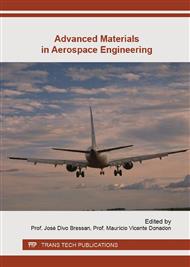p.1
p.20
p.35
p.52
p.62
p.75
p.88
p.104
Compression Failure Modes of Carbon Fiber Fabric Scraps/Epoxy Laminates
Abstract:
The composite prepreg waste is still an environmental challenge. In the last decade, several researchers have been studying the recycling and reuse processes of composite components, mainly to use in secondary (non-structural) components. In this paper, uncured aerospace grade prepreg scraps resulted from the production waste were used to manufacture laminates. The carbon reinforcement of the prepreg presented plain weave style fabric. To manufacture the laminates the hand-lay up process was used, randomly positioning the scraps and without respecting the preferred directions of the warp and weft. Therefore, the resulting laminate is multidirectional (in the plane) and orthotropic. The cure was performed in autoclave at the maximum temperature of (180 ± 1)°C and pressure of 100 psi. This laminate was tested in compression according to standard SACMA SRM 1R-94. The results show an average compression resistance equivalent to that of laminates produced with continuous layers, although with a higher dispersion. In order to understand this variation, the fracture surfaces of the laminates were analyzed by scanning electron microscopy (SEM) in order to identify the failure modes. The specimens present shear and interlaminar failure modes, in addition to a mixed mode of failure (a transition between the shear and interlaminar failures). For the same specimen, the analysis of the internal arrangement of the fibers shows that changes in failure modes occur in regions where the carbon fabric is not continuous, i.e. there are joinings of scraps. It was also observed that none of the compression tests resulted in catastrophic failure of the specimens, possibly due to a greater resistance to fracture growth in the presence of mixed failure mode.
Info:
Periodical:
Pages:
52-61
Citation:
Online since:
January 2016
Keywords:
Price:
Сopyright:
© 2016 Trans Tech Publications Ltd. All Rights Reserved
Share:
Citation:


